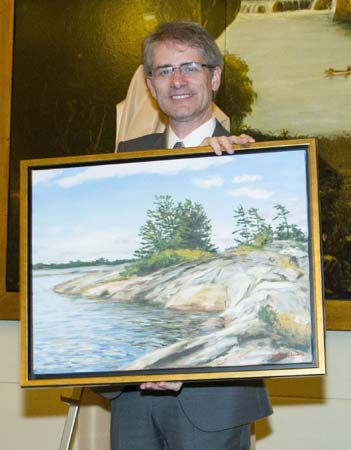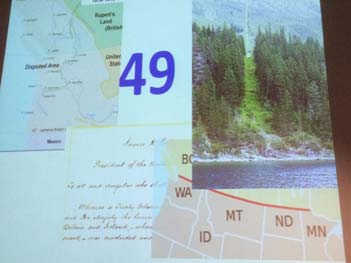Ben Alman Research and Science Lecture: “49”

Ben Alman
|
Ben Alman returned to
Toronto on January 9th, 2015
to give the Ben Alman Research
and Science lecture at UHN.
As many readers know, Dr.
Alman is the former Chair of
the Division of Orthopaedic
Surgery and Vice-Chair of
Research in the Department
of Surgery at the University
of Toronto. He was recruited
to Duke University to Chair their Department of
Orthopaedic Surgery in 2013. However, he still maintains
a significant presence in Toronto with a research
laboratory at the SickKids Research Institute.
His intriguing title aptly focused the audience on the
objectives of the talk: comparing and contrasting the
differences between research and innovation funding
north and south of the 49th parallel. After a brief history
and geography lesson outlining the establishment and
preservation of the 49th parallel, Dr. Alman highlighted
how, as an Americanadian (an individual who is legally
allowed to work in both countries), he is ideally positioned
to evaluate differences in research and innovation
funding in Canada and America. Surprisingly, researchers
in both Canada and the US feel that the grass appears
greener on the other side of the border. In reality, both
countries have advantages and disadvantages when it
comes to research and innovation funding.
He provided an excellent tour of his research from
his original work on desmoid cell tumours through to
the establishment of ScarX Therapeutics with the help
of MaRS innovation. His initial experiments on desmoid
cell tumours led to identifying beta-catenin as a
protein instrumental in hypertrophic scan formation.
Further analysis led to the identification of Nefopam,
a non-opioid analgesic, as a therapeutic that decreases
beta-catenin levels thereby decreasing scar formation.
With this discovery, Dr. Alman began the process to take
Nefopam to market (through MARS) and established
ScarX Therapeutics with the end goal of a topical product
that could reduce scar hypertrophy.
|
With his move to Duke in 2013, Dr. Alman is investigating
molecules and proteins produced by macrophages
that may help fractures heal quicker in the elderly.
Despite slow progress in obtaining internal grant funding
at Duke, the university has a streamlined process
to establish external funding from the many industryacademic
collaborations in the local area.
Dr. Alman then addressed the differences between
research and innovation funding north and south of the
border. The NIH has approximately 30 times the amount
of funds available for grants compared to the CIHR. Dr.
Alman argued that this is a grossly inflated figure with the
actual amount available for research almost identical on a
per capita basis. He provided his own grant examples to
demonstrate that, after indirect costs and salaries, his NIH
grants provided US$350 000 for research per year compared
to his CIHR grants that provide C$380 000 per year.
Like the CIHR, the NIH has curtailed growth in research
fund allocation, with levels of research funding plateauing
approximately 5 years ago in both countries. He concluded
that the grass was not always greener on the other side.

Ben Alman illustrates the 49th parallel
James Rutka asked why different institutions withheld
different indirect costs from NIH grants. Dr Alman
replied that these are mainly based on fixed costs that
differ due to local market conditions such as real estate
costs, minimum wage, and utilities.
Michael Fehlings asked if we needed to focus on producing
surgeon scientists with specific skills in translational
medicine. Ben felt that rather than churning out more surgeons
who wanted to isolate themselves as clinical epidemiologists
or basic scientists, we needed to encourage the next
generation of surgeon scientists to take the lead in solving
clinical problems by collaborating with dedicated scientists
at the lab bench, and those involved in clinical trials that
will ultimately lead to clinical solutions.
Mark Camp, Orthopaedic Surgeon,
Hospital for Sick Children
Assistant Professor, Department of Surgery,
University of Toronto
|